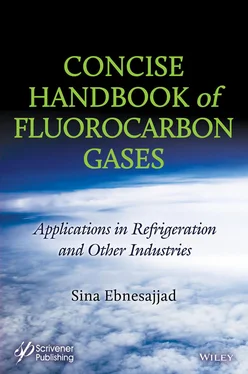1.6 Specialty Fluorochemicals
There are many types of specialty fluorochemicals with important applications. They are usually quite expensive and are used in small quantities. Here are some examples. Fluorinated surfactants, significant as they are, are consumed in relatively small quantities. They have not been included in this book because there are already competent books about them [22].
Another group of “fluorinated” compounds are drugs and pharmaceuticals, nearly 20%, containing one or more atoms of fluorine in their structures. Examples of common medicine containing fluorine include Prozac, Cipro and Paxil. In spite of minor presence in the structure of drugs fluorine atom affects the characteristics of pharmaceutical substantially. They are not covered in this book because a separate volume would be needed for their coverage. Journal articles and other books continue to publish information about research and development of new fluorinated chemicals synthesized [23–25].
Another important group of fluorocarbons are used in surgeries as inhalation anesthesia. The benefits over the old compounds include non-toxicity, non-flammability, general metabolically stability, ease of detoxification in the liver, rapid recovery and very few side effects. Commercial examples of those fluorocarbons include methoxyflurane, isoflurane, sevoflurane and desflurane. A popular compound was enflurane which is no longer commonly used but it is effective in relaxing the uterus in pregnant women.
1. Cottrell, T.L., The Strengths of Chemical Bonds , 2d ed., Butterworth, London, 1958.
2. Darwent, B. deB., National Standard Reference Data Series, National Bureau of Standards, no. 31, Washington, 1970.
3. Benson, S.W., J. Chem. Educ. , 42, 502, 1965.
4. Kerr, J.A., Chem. Rev. , 66, 465, 1966.
5. National Aeronautics and Space Administration (NASA), https://ozonewatch.gsfc.nasa.gov/, May 2020.
6. The Ozone Hole, www.theozonehole.com/dobsonunit.htm, May 2020.
7. Dobson, G.M.B., Dept of Physics, Oxford University, May 2020.
8. Booten, C., Nicholson, S., Mann, M., Abdelaziz, O., Refrigerants: Market Trends and Supply Chain Assessment , Clean Energy Manufacturing Analysis Center, Department of Energy, NREL/TP-5500-70207, February 2020.
9. Refrigerant Market Size Worth $30.37 Billion By 2025 at CAGR: 5.3%, Refrigerant Market Size & Share Report By Product (Fluorocarbon, Hydrocarbon, Inorganic) , Grand View Research, www.grandviewresearch.com, May 2020.
10. Refrigerant Market by Type, and by Application - Global Trends & Forecasts to 2020 , MarketsandMarkets, www.marketsandmarkets.com.
11. Global Market Insights, www.gminsights.com, Fluorochemicals Market Size by Product, by Application, Industry Outlook Report, 2015–2024.
12. Micromarket Monitor, www.micromarketmonitor.com, Nov 2019.
13. Global $31 Billion Refrigerants Market Forecast to 2023 , published by CISION PR, www.prnewswire.com, March 2019.
14. CHILLVENTA Insights - The Market Analysis, www.chillventa.de, 2019.
15. Chemical Economics Handbook , HIS Markit, https://ihsmarkit.com, 2019.
16. Fluoropolymers Market - Global Industry Trends & Forecasts to 2019 www.marketsandmarkets.com, 2019.
17. Fluoropolymers - Chemical Economics Handbook (CEH) | HS , www.ihs.com, 2019.
18. India Fluoropolymer & Fluorosurfactant Market Report, www.grandviewresearch.com, 2019.
19. Fluoroelastomer Market - Global Trends & Forecast to 2019, www.marketsandmarkets.com, May 2019.
20. Fluoroelastomers, Chemical Economics Handbook , IHS Markit, https://ihsmarkit.com/products/fluoroelastomers-chemical-economics-handbook.html, April 2019.
21. Fluoropolymer Coating Market Report - Global Forecast till 2025, www.marketresearchfuture.com/reports/flouropolymer-coating-market-4844, ID: MRFR/CnM/3416-HCR, May 2020.
22. Kissa, E., Fluorinated Surfactants: Synthesis, Properties, Applications , 2nd ed, CRC Press, 2001. 23. Gakh, A. and Kirk, K.L., Fluorinated Heterocycles , 1st ed, American Chemical Society, 2009. 24. Knepper, T.P. and Lange, F.T., Polyfluorinated Chemicals and Transformation Products, in: The Handbook of Environmental Chemistry , 2012 Ed, Springer, 2011.
23. Ameduri, B. and Boutevin, B., Well-Architectured Fluoropolymers: Synthesis, Properties and Applications , 1st ed, Elsevier Science, 2004.
24. Regulation (EC) No 842/2006 of The European Parliament and of the Council of 17 May 2006 on certain fluorinated greenhouse gases. Off. J. Eur. Union , 2006.
25. Directive 2006/40/EC of The European Parliament and of the Council of 17 May 2006 relating to emissions from air-conditioning systems in motor vehicles and amending Council Directive 70/156/EC. Off. J. Eur. Union , 2006.
2
Classification and Description of Commercial Fluorinated Compounds
Fluorine is present in the air we breathe, the water we drink and the rocks beneath us, as well as in numerous synthetic polymers, pharmaceuticals, agrochemicals and other formulations. Fluorine in the atmosphere, oceans, biosphere and earth’s crust might be grouped together as the fluorosphere to understand the effects of human activities on the environment [1].
This chapter begins with a short discussion of sources of fluorinated chemicals. Most existing fluorochemicals are organic and virtually all of them are synthetic, that is manufactured. Fluorochemicals as a class of materials are fairly new; all of them have been produced since 1930’s. The rest of this chapter primarily covers fluorocarbon gases and liquids. A short explanation of commercial fluoropolymers rounds off the Chapter.
2.1 Fluorine and Fluorochemicals
Organic fluorine compounds rarely occur naturally in contrast to bromine and chlorine products. The most famous naturally existing organic fluorine-containing compound is probably monofluoroacetic acid (FCH 2COOH). This compound is found in a South African plant called “Gifblaar,” which is known to be so poisonous that ingesting only a half of its leaf is enough to kill a cow. In 2003, a Chinese research group discovered fluorine-containing compounds from the extract of a marine sponge called Phakellia fusca . Another example of a naturally occurring organic fluorine containing compound is called nucleocidin. Even the presence of elemental fluorine has been reported in fluorspar (CaF 2) containing radioactive uranium [2].
None of the rare natural organic compounds are useful as a source for C-F bonds for commercial production of chemicals. The easiest route to produce carbon fluorine (C-F) bond is via hydrofluoric acid (HF). Acid grade fluorspar (CaF 2) is combined with sulfuric acid to produce HF and calcium sulfate. Chloroform is produced by and chlorination of methane. Catalytic reaction of HF and CHCl 3produces CHClF 2, which is the starting point for producing many fluorocarbons.
Development of fluorine chemistry allowed economically viable fluorinated chemicals and polymers to be produced during the first half of 20 thcentury. The first commercial fluorine products of any kind go back to 1930’s, developed to meet the evolving industrial needs for compounds such as new refrigerants. The traditional agents used in refrigeration included ammonia, carbon dioxide, sulfur dioxide, hydrocarbons and methyl chloride. These refrigerants suffered from shortcomings including toxicity, flammability, instability and poor efficiency in the refrigeration cycle. Consequently, the challenges in the development of new agents consisted of the following characteristics:
Читать дальше












